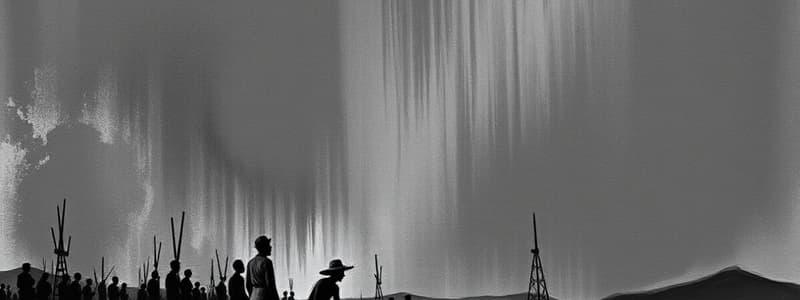Podcast
Questions and Answers
What unique artistic technique does William Kentridge utilize in his animation process?
What unique artistic technique does William Kentridge utilize in his animation process?
Kentridge uses a single sheet of paper for his animation, allowing multiple alterations through drawing, photographing, erasing, and modifying.
How has Kentridge's early experiences with apartheid influenced his artistic content?
How has Kentridge's early experiences with apartheid influenced his artistic content?
Kentridge's early experiences witnessing apartheid, particularly events like the Sharpeville massacre, deeply inform the political themes in his artwork.
What notable recognition did Kentridge receive in 2009?
What notable recognition did Kentridge receive in 2009?
Kentridge was included in the Time 100 list in 2009.
Describe Kentridge's contribution to public art venues.
Describe Kentridge's contribution to public art venues.
What longtime influence did Kentridge's parents have on his involvement in the arts?
What longtime influence did Kentridge's parents have on his involvement in the arts?
What role does memory play in Kentridge's work, particularly concerning South Africa's apartheid history?
What role does memory play in Kentridge's work, particularly concerning South Africa's apartheid history?
How does Kentridge use color symbolism in his art, particularly with red and blue?
How does Kentridge use color symbolism in his art, particularly with red and blue?
In what ways does Johannesburg shape Kentridge's films and artistic narratives?
In what ways does Johannesburg shape Kentridge's films and artistic narratives?
What duality does Kentridge explore through the water motif in his works?
What duality does Kentridge explore through the water motif in his works?
How does Kentridge convey the unreliable nature of landscapes as witnesses to history?
How does Kentridge convey the unreliable nature of landscapes as witnesses to history?
Flashcards are hidden until you start studying
Study Notes
William Kentridge: Overview
- South African artist renowned for charcoal drawings, animations, theater productions, and films.
- Active in the art scene for over 35 years, focusing primarily on charcoal, enhanced occasionally with red and blue.
- Recognized for deeply political content and unique artistic techniques, making him among South Africa's top artists.
- Holds the title of South Africa's most successful living artist; a typewriter drawing sold for over R13 million is the most expensive by a South African.
Key Achievements
- Kentridge's artwork is housed in prestigious institutions including MoMA (New York), Tate Modern (London), Museum of Contemporary Art (Chicago), and the Louvre (Paris).
- Acknowledged in the Time 100 list in 2009 and has lectured at Harvard University.
- His works have been showcased in notable public venues like Times Square.
Early Life and Education
- Born in 1955 in Johannesburg to lawyer parents, influential in opposing apartheid.
- Witnessed the impact of apartheid early in life; significant experiences include the Sharpeville massacre at age six.
- Formative education included studies in politics and African studies at the University of the Witwatersrand and fine arts at the Johannesburg Art Foundation.
Artistic Journey and Philosophy
- Initially struggled with identifying his true vocation; dabbled in art, acting, and filmmaking.
- Returned to drawing after friends encouraged him, realizing he could merge multiple interests without specializing.
- Developed a unique animation process using one sheet of paper, enabling up to 100 alterations for expressive movement.
Artistic Techniques
- Kentridge's animation involves drawing, photographing, erasing, and modifying on a single paper sheet— a method differing from traditional animation requiring numerous drawings.
- This crude technique imbues a vintage aspect and evokes themes of memory and historical traces.
Major Themes in His Work
- Resilience of memory highlighted through charcoal residue that permanently marks the paper, alluding to South Africa's apartheid history.
- Elements of resistance art present in works prior to 1994, focusing on racial contrasts.
- Color symbolism: red for violence and suffering; blue for peace and introspection.
Symbolism and Dualities
- Common symbols include megaphones, typewriters, and navigational instruments, representing communication and power.
- Explores duality within the self and society, often incorporating autobiographical elements and conflicting motivations in his characters.
Johannesburg's Influence
- Johannesburg serves as a critical backdrop in Kentridge’s films, reflecting its contradictory nature— a burgeoning metropolis lacking natural landmarks yet a site of historical atrocities.
- The city’s landscape, formed by mining, symbolizes the socio-economic disparities between wealthy and underprivileged communities.
Water Motif
- Water features prominently in his works, representing both natural scarcity above ground in Johannesburg and its overwhelming presence underground due to mining.
- This duality mirrors the artificial constructs of privilege above the earth and hardship underground, highlighting racial inequalities.
Conclusion
- Kentridge’s work intricately weaves complex narratives, employing a distinct visual language over three decades.
- His artistry embodies the struggle to extract meaning and truth from a world marked by historical trauma and social ambiguity, with viewers engaged in a restless inquiry of their own interpretations.### Kentridge and the Landscape
- Water serves as both a need for irrigation in affluent areas and a danger to mining operations.
- Johannesburg’s historical landscape is changing, characterized by the disappearance of mine dumps due to advanced mining technology extracting gold from previously discarded ground.
- Kentridge emphasizes the unreliable nature of landscapes as witnesses to history, illustrating that significant events often leave no visible traces.
The Symbolism of Animals in Kentridge's Work
- Kentridge incorporates various South African wildlife, such as hyenas, panthers, cheetahs, warthogs, and rhinos, into his art.
- The hyena symbolizes evil spirits and mischief in South African culture, becoming a key figure in resistance art.
- Kentridge has a particular fascination with rhinos, representing both colonial destruction and misconceptions about Africa.
Historical Art Influences
- Influential artworks include Dürer’s inaccurately depicted rhino from 1515, which shaped Western perceptions despite its anatomical errors.
- Longhi's 1751 painting of Clara the rhinoceros highlights European exploitation and misunderstanding, showcasing the rhino as a symbol of power dynamics between Africa and Europe.
Critique of Human Obsession
- Rhino populations are endangered due to illegal poaching driven by demands for their horns in traditional medicine.
- The fascination with rhinos reflects humanity's destructive tendencies in the pursuit of power and resources.
Kentridge's Artistic Techniques
- Kentridge explores the concept of time through layered artworks, referencing slow photographic processes that capture the passage of time.
- Reversal of time is a recurring theme, transforming chaotic actions into ordered sequences in his films.
Reference to Historical Artworks
- Kentridge draws inspiration from notable artists such as Goya, Turner, and Renoir, emulating their themes of violence and human suffering.
- His triptych, "The Boating Party," contrasts Renoir’s work with a more violent commentary on apartheid-era South Africa.
Integration of Text and Theater
- Text plays a significant role in Kentridge's artwork, often intertwined with visual elements, influenced by the Dada movement.
- His theater background informs his creative process, merging art with stage performances and constructing mini-theaters for filmed artworks.
Artistic Phases and Historical Context
- Kentridge's career is divided before and after 1994, with pre-1994 works classified as Resistance art and post-1994 works identified as multimedia.
- The end of apartheid in 1994 marks a pivotal moment in South Africa’s history and influences Kentridge’s evolving artwork.
Importance of Kentridge's Art
- Kentridge is recognized as a pivotal artist whose work engages with complex themes, prompting deep thought and reflection.
- His art speaks to universal themes despite its South African origins, addressing biography, history, identity, and colonialism through visual means.
Future Analysis
- Additional videos will further examine Kentridge's resistance artworks and multimedia creations, providing a deeper understanding of his layered narratives and symbols.
William Kentridge: Overview
- Renowned South African artist recognized for charcoal drawings, animations, theater productions, and films, showcasing a 35+ year career.
- Primarily uses charcoal, occasionally enhanced with red and blue, highlighting political content and innovative techniques.
- Holds the title of South Africa's most successful living artist, with a typewriter drawing that sold for over R13 million, setting the record for the most expensive South African art piece.
Key Achievements
- Kentridge's works are featured in prestigious institutions like MoMA, Tate Modern, Museum of Contemporary Art, and the Louvre.
- Included in the Time 100 list of influential people in 2009 and served as a lecturer at Harvard University.
- Noteworthy public displays, including presentations in Times Square, enhance his global visibility.
Early Life and Education
- Born in 1955 in Johannesburg to parents active against apartheid, shaping his artistic perspective.
- Significant early exposure to apartheid's impact through events like the Sharpeville massacre at age six.
- Studied politics and African studies at the University of the Witwatersrand and fine arts at the Johannesburg Art Foundation, informing his artistic narrative.
Artistic Journey and Philosophy
- Initially uncertain about his career path, exploring art, acting, and filmmaking before focusing on drawing.
- Encouraged by friends to revisit drawing, he discovered a way to integrate his diverse interests without specialization.
- Innovated a unique animation technique using a single sheet of paper, allowing multiple alterations to create expressive motion.
Artistic Techniques
- Kentridge's animation process entails drawing, photographing, erasing, and modifying on one sheet of paper, contrasting with traditional animation methods.
- This approach adds a vintage quality, emphasizing themes of memory and historical acknowledgment in his work.
Major Themes in His Work
- The permanence of charcoal marks symbolizes the resilience of memory, reflecting on South Africa's apartheid history.
- His early works incorporate resistance art themes, focusing on racial contrasts, especially leading up to 1994.
- Color symbolizes significant themes: red represents violence and suffering, while blue signifies peace and reflection.
Symbolism and Dualities
- Common symbols in Kentridge's work, such as megaphones, typewriters, and navigational tools, convey communication and power dynamics.
- Explores self and societal dualities, often weaving autobiographical elements and conflicting motivations into character narratives.
Johannesburg's Influence
- Johannesburg is a vital setting in Kentridge’s films, representing the city’s contradictions as a growing metropolis amid a history of violence.
- The mining-influenced cityscape highlights the socioeconomic divides between the wealthy and underprivileged populations.
Water Motif
- Water symbolizes the dichotomy of scarcity above ground in Johannesburg and its abundant presence underground due to mining activities.
- This duality illustrates privilege versus hardship, underscoring racial inequalities and social disparities in the landscape.
Conclusion
- Kentridge's body of work crafts intricate narratives over three decades, using a distinctive visual language.
- His artistry reflects the quest for meaning in a world shaped by historical trauma and societal complexities, engaging viewers in continuous interpretative exploration.
Kentridge and the Landscape
- Water serves dual purposes: a necessity for irrigation in affluent areas and a threat to mining operations.
- The evolving Johannesburg landscape, marked by the elimination of mine dumps, showcases advanced mining technology extracting gold from neglected grounds.
- Kentridge highlights the unreliable nature of landscapes as historical witnesses, emphasizing the complexity of memory and change.
Studying That Suits You
Use AI to generate personalized quizzes and flashcards to suit your learning preferences.




